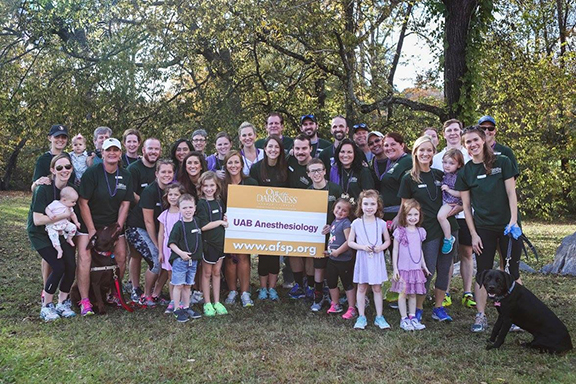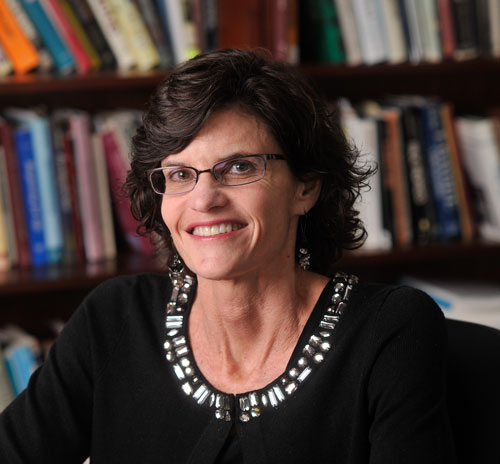 Residents from the UAB School of Medicine organized teams for the 12th annual Out of the Darkness community walk held last November. Hosted by the Alabama chapter of the American Foundation for Suicide Prevention (AFSP), the three-mile course was a non-competitive walk through Heardmont Park to raise awareness of the importance of mental health and suicide prevention, as well as to raise funds for further research and education.
Residents from the UAB School of Medicine organized teams for the 12th annual Out of the Darkness community walk held last November. Hosted by the Alabama chapter of the American Foundation for Suicide Prevention (AFSP), the three-mile course was a non-competitive walk through Heardmont Park to raise awareness of the importance of mental health and suicide prevention, as well as to raise funds for further research and education.
“There were residents, faculty from both UAB and the VA, nurses, fellows, and even a few friends from outside UAB that joined our team,” says Josh Woolard, M.D., a CA-3 resident in the Department of Anesthesiology and Perioperative Medicine who led the department’s team of about 40 walkers.
More than 1,800 people registered for the walk near Oak Mountain, which included booths for more information and resources. Shoes belonging to suicide victims were placed alongside the course to serve as tangible reminders of those whose lives were lost; flags representing each military active duty suicide from the past year lined paths as well.
 Approximately 40 faculty, residents, and friends took part in the UAB Department of Anesthesiology and Perioperative Medicine's Out of the Darkness Walk team.“I was truly touched to see so many UAB teams—including Surgery, Anesthesia, Emergency Medicine, Psychiatry, and Public Health,” says resident Samantha Baker, M.D., who led the Department of Surgery’s team of walkers. “We were all moved by seeing the shoes of loved ones on the side of the walking path. It was such a concrete example of how many lives were lost.”
Approximately 40 faculty, residents, and friends took part in the UAB Department of Anesthesiology and Perioperative Medicine's Out of the Darkness Walk team.“I was truly touched to see so many UAB teams—including Surgery, Anesthesia, Emergency Medicine, Psychiatry, and Public Health,” says resident Samantha Baker, M.D., who led the Department of Surgery’s team of walkers. “We were all moved by seeing the shoes of loved ones on the side of the walking path. It was such a concrete example of how many lives were lost.”
Overall, the event raised $140,000. The AFSP relies on fundraising events such as the community walks to raise money for its work as the leading nonprofit dedicated to understanding and preventing suicide. Funds go to research, education, prevention, and advocacy, as well as support for survivors of suicide loss. AFSP has set a goal to reduce the national suicide rate 20 percent by 2025. Though it compiles numbers state-by-state, it also specializes in resources by profession, including toolkits and resources for physicians struggling with mental health.
“The biggest thing I took away from the walk was that so many people around us have been affected by suicide,” says Woolard. “It is truly a public health problem that has a huge impact on the community. It was great to see so many people there, but, of course, it was also sad to see all those people who have been affected by suicide one way or another.”
For more information, visit the American Foundation for Suicide Prevention. Specific resources for physicians are available here.
Helping Our Care Providers
 Sandra Frazier, Assistant Dean of Professional Development The data is in, and it’s depressing: An estimated 300 U.S. physicians die by suicide each year. According to the American Foundation for Suicide Prevention, for male physicians, the suicide rate is 1.41 times higher than the general male population; for female physicians, that number is 2.27 times higher. But how can this be? Those traits that make for outstanding doctors – self-sufficiency, perfectionism, intelligence, a high threshold for responsibility and caretaking – these all become double-edged swords when the pressure is on, work-life balance is off, and mental strain, fatigue, anxiety, or depression sets in. Doctors don’t like to become patients: Physicians who commit suicide are less likely to be on the receiving end of mental health treatment than non-physicians who commit suicide.
Sandra Frazier, Assistant Dean of Professional Development The data is in, and it’s depressing: An estimated 300 U.S. physicians die by suicide each year. According to the American Foundation for Suicide Prevention, for male physicians, the suicide rate is 1.41 times higher than the general male population; for female physicians, that number is 2.27 times higher. But how can this be? Those traits that make for outstanding doctors – self-sufficiency, perfectionism, intelligence, a high threshold for responsibility and caretaking – these all become double-edged swords when the pressure is on, work-life balance is off, and mental strain, fatigue, anxiety, or depression sets in. Doctors don’t like to become patients: Physicians who commit suicide are less likely to be on the receiving end of mental health treatment than non-physicians who commit suicide.
“As physicians, we often don’t let our guard down—we suffer in silence,” says Assistant Dean of Professional Development Sandra L. Frazier, M.D., F.A.S.A.M. “And then we become vulnerable. We can have all those wonderful traits, but they can also become dangerous. It just boils down to the fact that we’re not above the human condition.”
Dr. Frazier, who’s been with UAB for nearly 25 years, was named UAB’s first Physician Health Officer in 2006. She became Assistant Dean for Professional Development in 2011, a position that provides opportunities for coaching, as well as dealing with conflict and dysfunction. But her specialty lies in caring for caregivers. She and her team work with medical students, residents, fellows, and faculty at UAB to address issues such as anxiety, depression, burnout, and behavioral issues in a confidential setting.
With the mission of addressing professional health and wellness, Dr. Frazier oversees a safe space where doctors themselves can begin to heal. Located in the John Whitaker Building, Suite 504A, she and her team are available by appointment; no referrals are necessary (205-731-9799). [please link to: https://www.uab.edu/medicine/home/faculty-staff/professional-development]
Meanwhile, Dr. Frazier shares a few points for doctors to keep in mind when struggling:
When It’s You
Practice self-care: This can be hard in the midst of stressful, crisis-oriented professions, but step back routinely to acknowledge aspects of life that address your own humanity. Practice mindfulness or develop your spirituality; write a mission statement and reconnect with your purpose; spend time with friends, family, and colleagues. “We see some really tough things, and we can’t act like it doesn’t affect us. If we would slow down and share, we would be so much happier.”
Be open to the fact that you might need medical treatment: “Are you going to be a better physician with a treated medical condition or an untreated medical condition?” asks Frazier, who notes that patients want doctors who themselves are healthy and at the top of their game.
Don't be afraid to ask for help: Barriers to seeking help include fears of a lack of confidentiality, of stigma, of career implications, or can be as simple as a lack of time. “In our office, there’s not an electronic record and we don’t charge insurance. I start seeing people at 7:00 in the morning,” says Frazier.
When It’s a Colleague
This one is tricky. Most physicians are able to downplay or hide their personal struggles. As many people who’ve lost someone to suicide can tell you, they often had no idea what was going on underneath the surface. A couple of things you can do:
Note unexpected changes: Generally, if you see any clue at all, it’s a change in behavior, Dr. Frazier says. “He or she may be isolating; they may make more mistakes or may be disheveled.”
Be there for each other: Form a support network. “It’s not your job to diagnose your colleagues. It’s your job to express concern. You could just say ‘Are you okay? You’re looking a little sad.’” Don’t be afraid to connect with your co-workers sincerely. “Everybody looks like they have it together, but we know that sometimes they don’t,” she says. “We’ve got to have those people we can be real with.”
When It’s an Emergency
Call 911. The National Suicide Prevention Lifeline is available 24/7 at 1-800-273-8255.
By Julie Cole Miller
Posted January 12, 2018